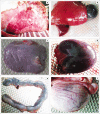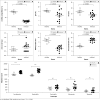Peste des petits ruminants virus infection of Black Bengal goats showed altered haematological and serum biochemical profiles
- PMID: 30326714
- PMCID: PMC6324080
- DOI: 10.4102/ojvr.v85i1.1595
Peste des petits ruminants virus infection of Black Bengal goats showed altered haematological and serum biochemical profiles
Abstract
In Bangladesh, veterinarians often claim to reduce the mortality of natural peste des petits ruminants (PPR) outbreaks with the help of supportive fluid and electrolyte therapy. Information on haematological and biochemical parameters of PPR-infected goats, which is often altered because of associated tissue damages, is necessary to formulate the appropriate supportive therapy. This study determined the haematological and serum biochemical parameters of Black Bengal goats naturally infected with PPR virus. Blood and serum samples from 13 PPR-affected Black Bengal goats from 13 field outbreaks and 5 healthy goats were collected and analysed by routine haematological and biochemical examination. Haematological analysis of PRR-affected goats showed severe anaemia characterised by significant decrease in the values of haemoglobin, total erythrocyte counts (TECs) and packed cell volume (PCV). On the contrary, PPR-affected goats showed marked leucocytosis with absolute increase in lymphocytes and neutrophils counts compared to the healthy goats. Biochemical analysis revealed significant decrease in total protein and albumin level and increased creatine kinase, aspartate transaminase and alanine transaminase that mirrored the gross and histopathological changes in the PPR-affected goats. Significant increase in the values of sodium and chloride ions was found in the sera of PPR-infected goats. Peste des petits ruminants virus altered the haematological and serum biochemical parameters of the infected goats. Antidiarrheal agents with aqua solution together with other drugs to support liver and kidney function could help improve therapy of PPR-infected goats.
Keywords: PPR; biochemical analysis; electrolyte imbalance; goats; haematology.
Conflict of interest statement
The authors declare that they have no financial or personal relationships that may have inappropriately influenced them in writing this article.
Figures






References
-
- Das S., Nath R., Balamurugan V., Choudhury R. & Devi M., 2015, ‘Haemato-biochemical analysis of goats naturally infected with peste des petits ruminants’, International Journal for Research in Emerging Science and Technology 2, 19–24.
MeSH terms
LinkOut - more resources
Full Text Sources
